
Photo from wikipedia
Abstract The hot dry rock (HDR) development is a hot research field in recent years. Numerical simulation based on thermal-hydraulic-mechanical coupling model is a key technique for the HDR development… Click to show full abstract
Abstract The hot dry rock (HDR) development is a hot research field in recent years. Numerical simulation based on thermal-hydraulic-mechanical coupling model is a key technique for the HDR development evaluation. The calculation of geomechanics is an important part of the coupling thermal-hydraulic-mechanical simulation, and it is usually implemented by finite element method. However, meshing methods of geological modeling software are designed to serve seepage simulation, and grid quality cannot meet the requirements of finite element method. In this paper, finite volume method has been proposed to calculate the distribution of underground stress field, in order to solve the problem of discontinuous grid vertexes and calculation failure caused by finite element method. In addition, the mesh of geological modeling software is for finite difference method or finite volume method, which cannot be used directly by finite element method. In this paper, spatial discretization pattern of quasi static stress balance equation based on the finite volume method is obtained, the local grid refinement algorithm is proposed, the solution workflow of thermal-hydraulic-mechanical (THM) coupling model is presented, and the solution of displacement discretization equations and THM one way coupling model are implemented by C++ programming language. Finally, the feasibility and accuracy of the finite volume method of stress field calculation are verified through a series of numerical test examples compared with commercial finite element software. Several THM coupling simulation cases of enhanced geothermal system are presented by finite volume method. Numerical test results show that the calculation error between finite volume method and finite element method is less than 1%. Moreover, the variation of principal stress, induced by pore pressure and thermal stress, can reach 8 to 20 MPa. The finite volume method provides a unified technical framework for geomechanics and thermal-hydraulic calculation. Moreover, the method can be directly combined with geological modeling software without using two sets of grids. The results prove that the finite volume method would be a promising approach for thermal-hydraulic-mechanical simulation.
Journal Title: Geothermics
Year Published: 2021
Link to full text (if available)
Share on Social Media: Sign Up to like & get
recommendations!